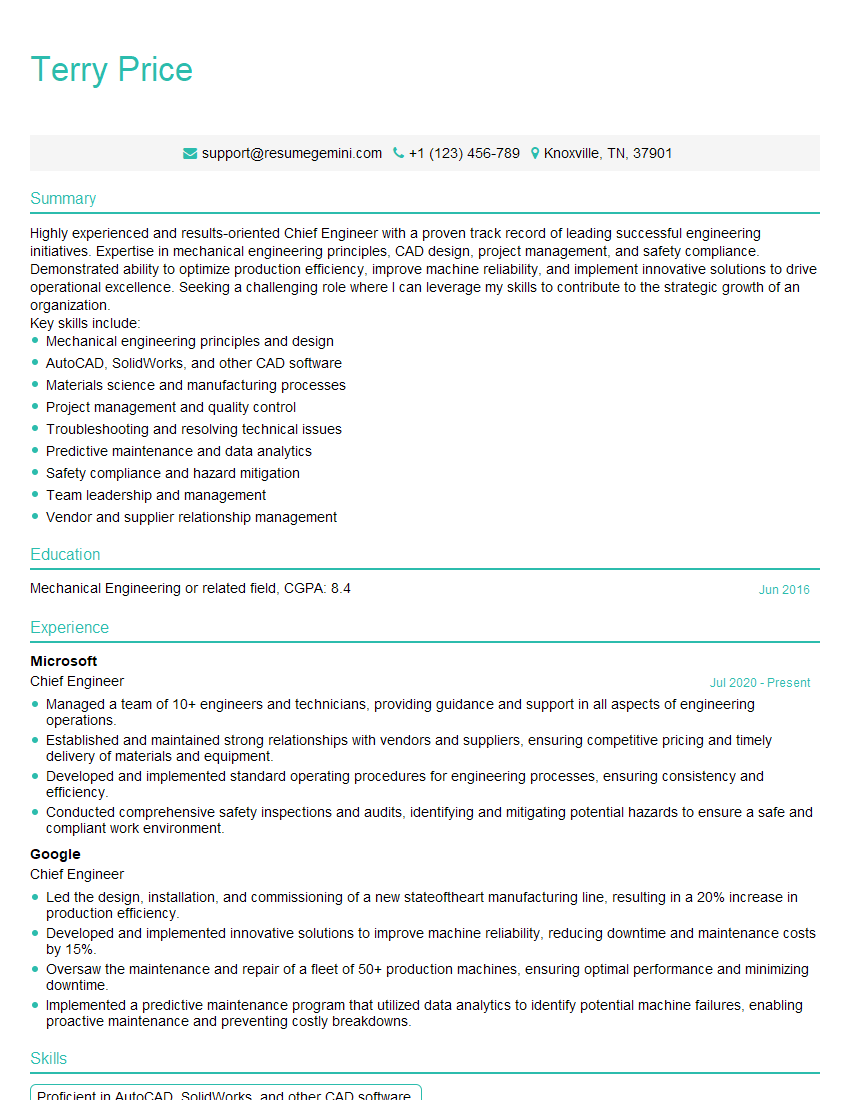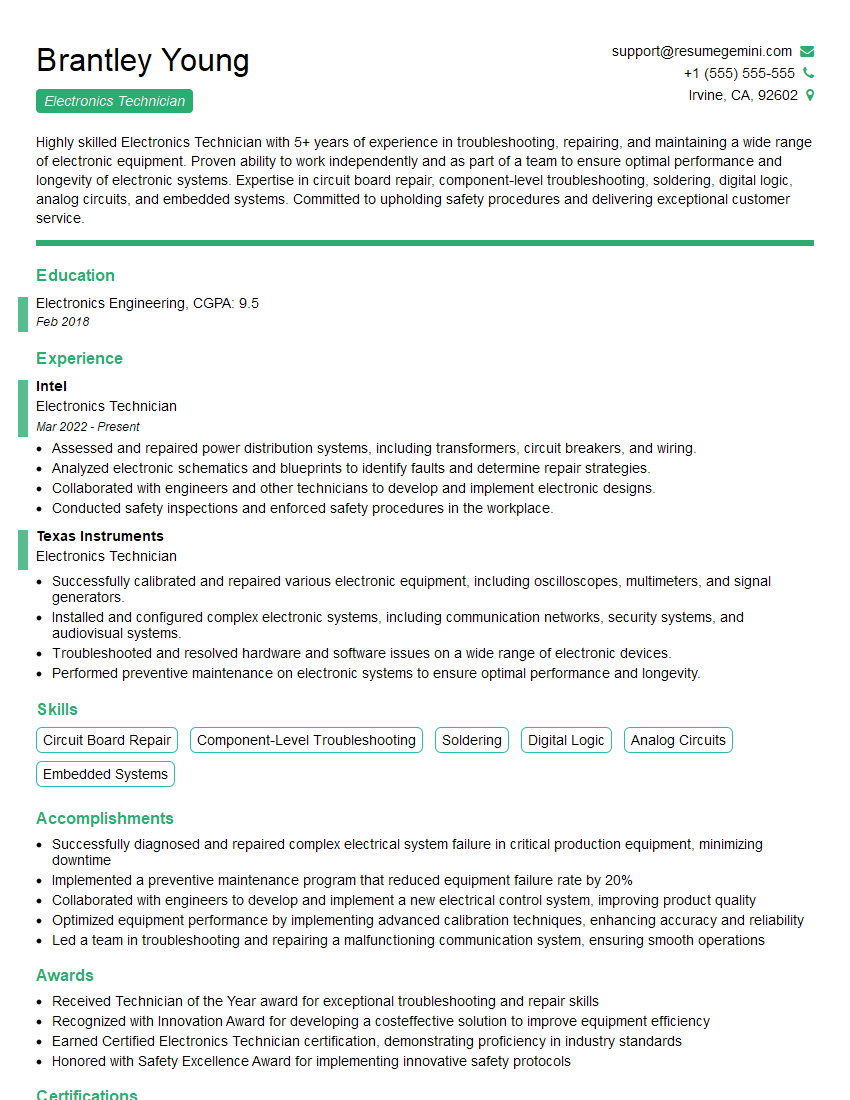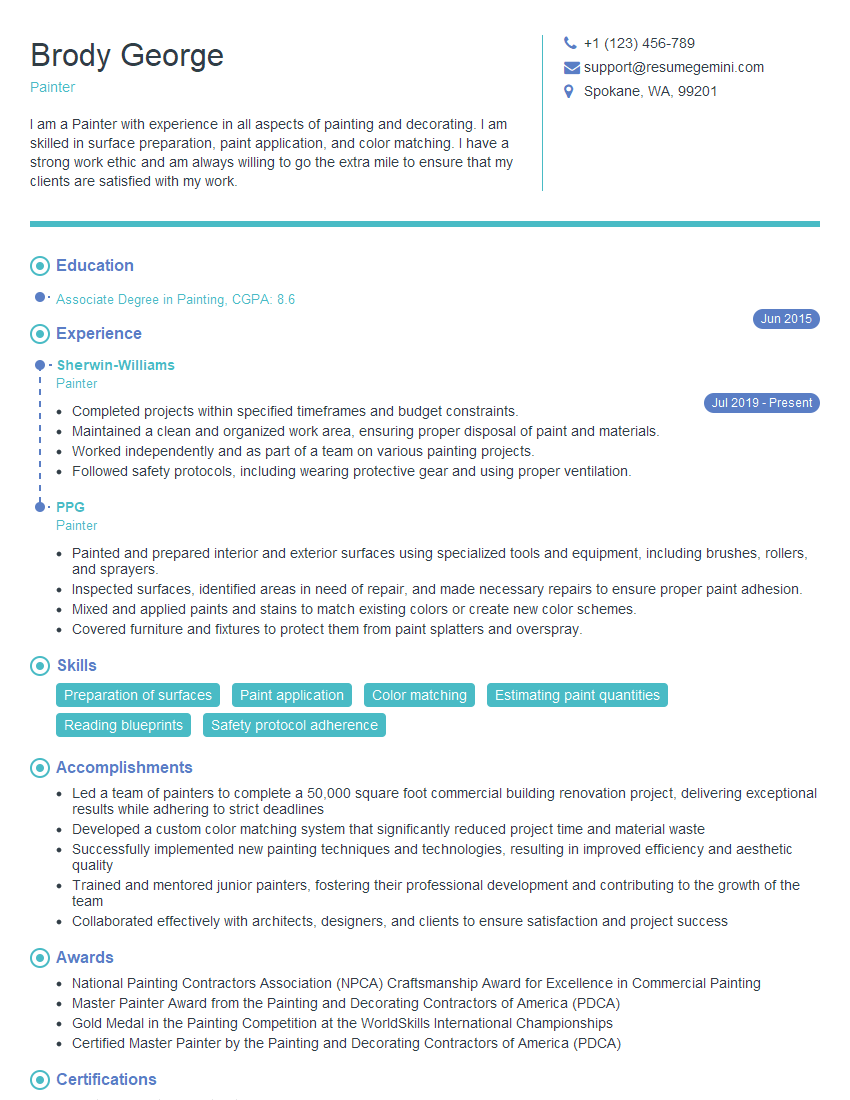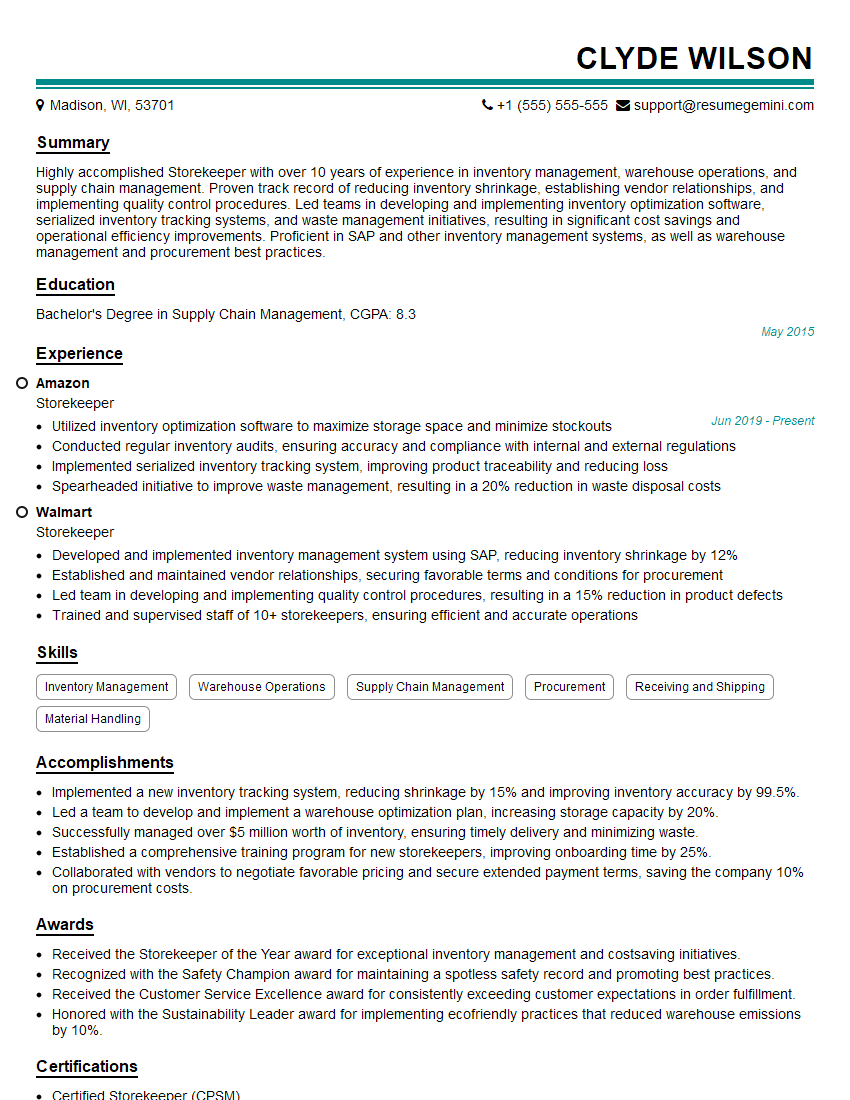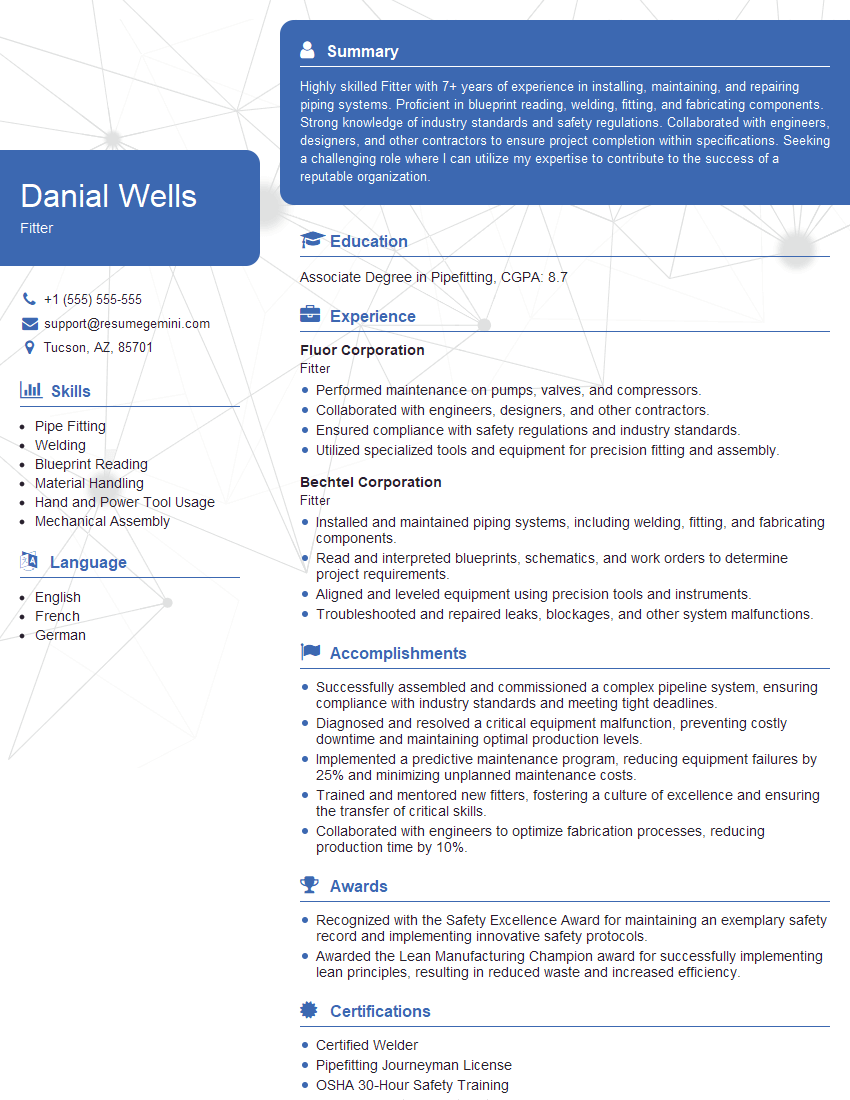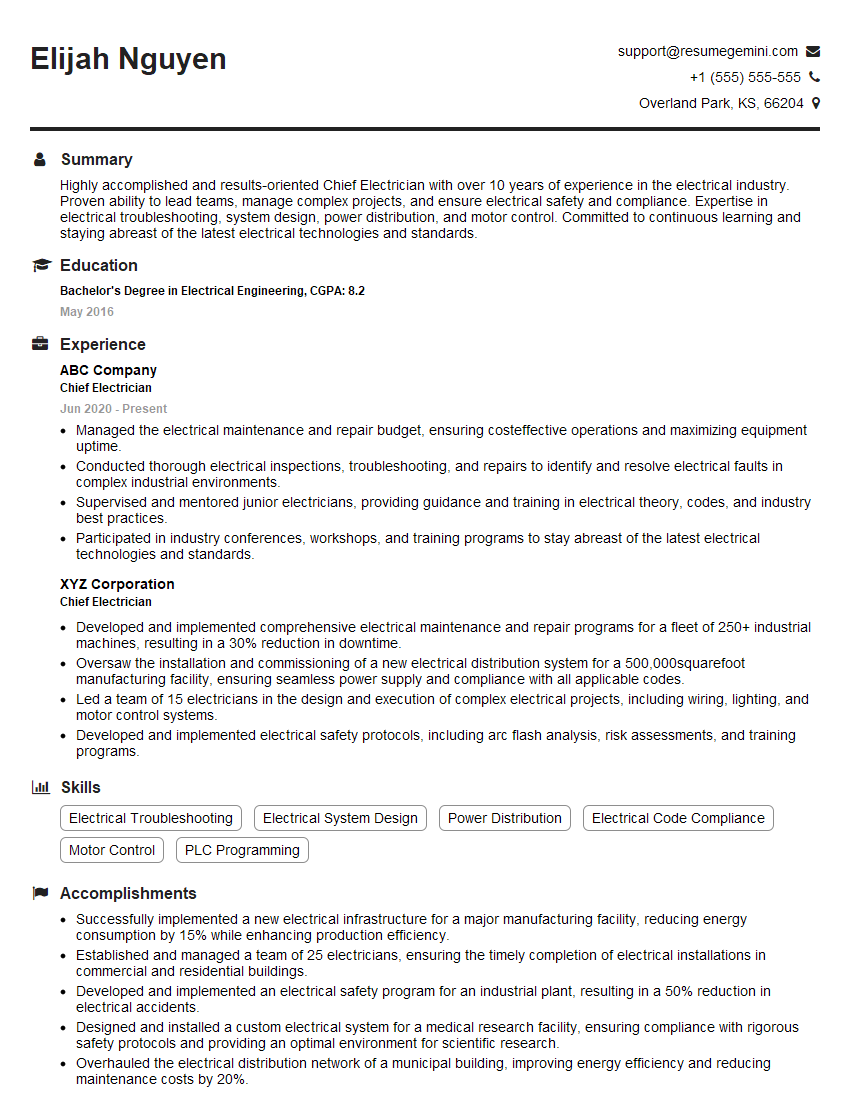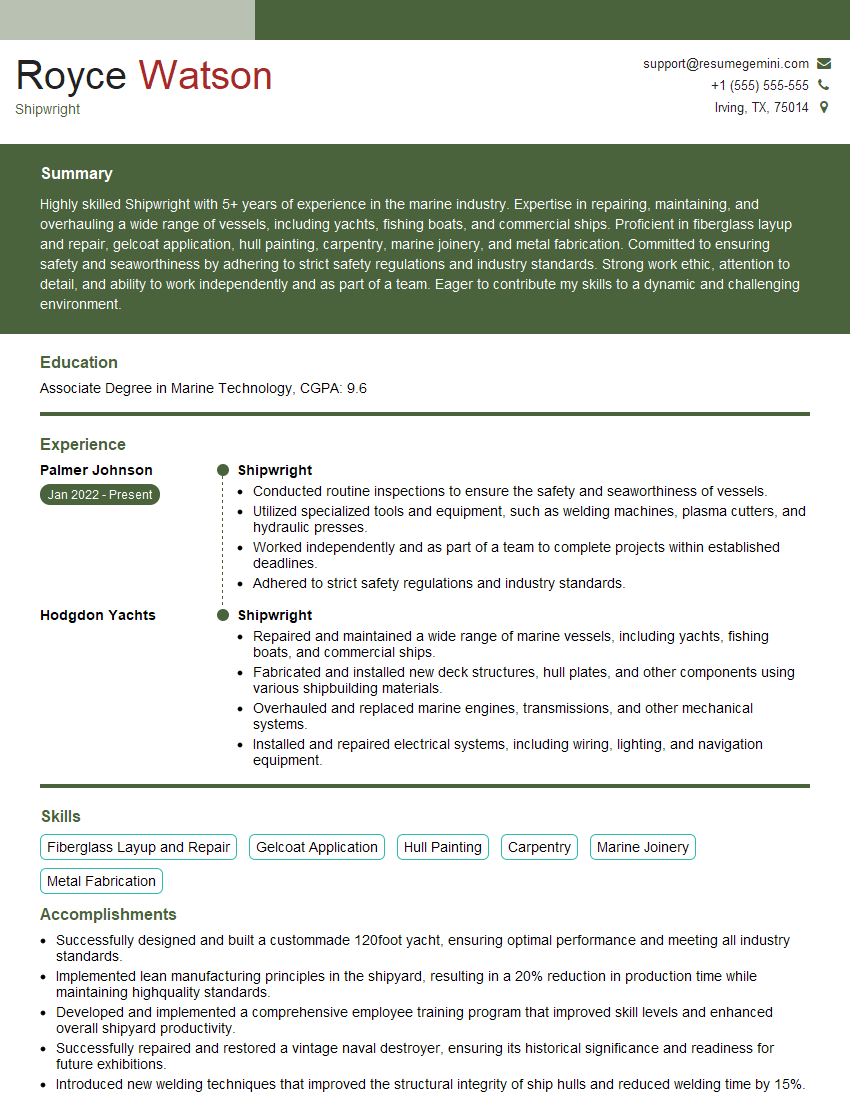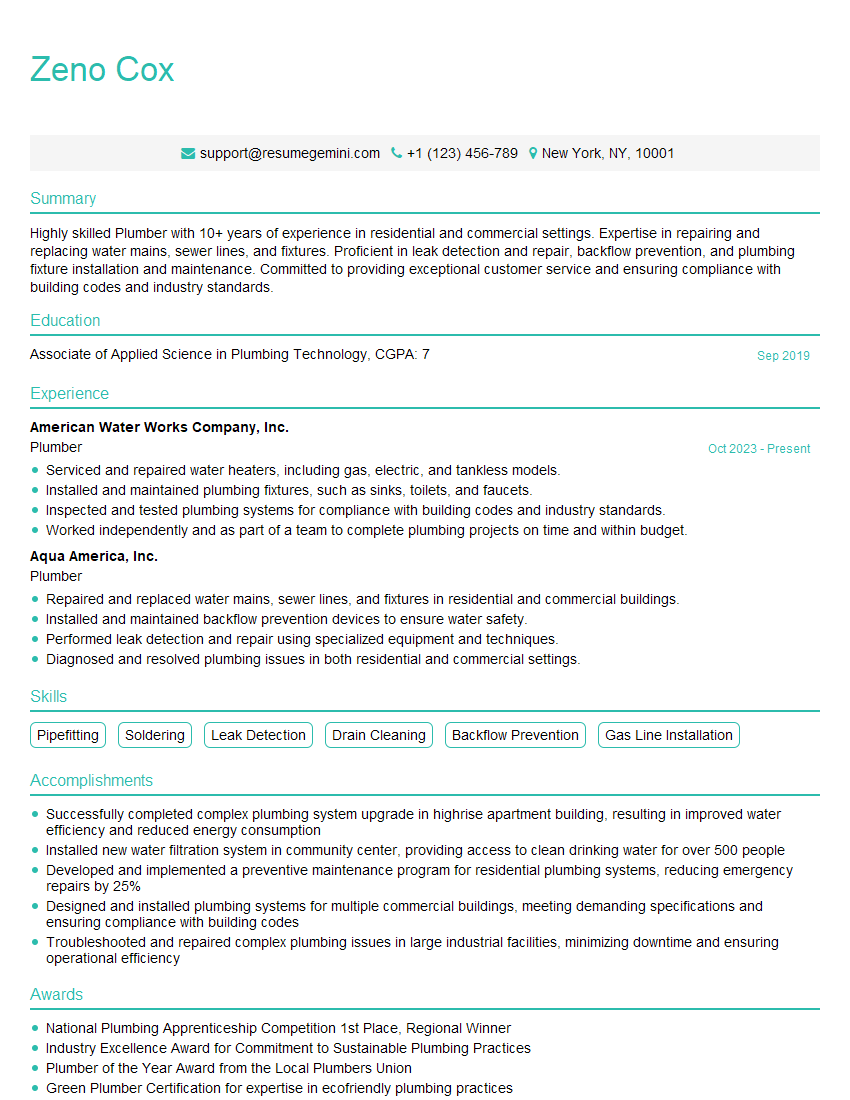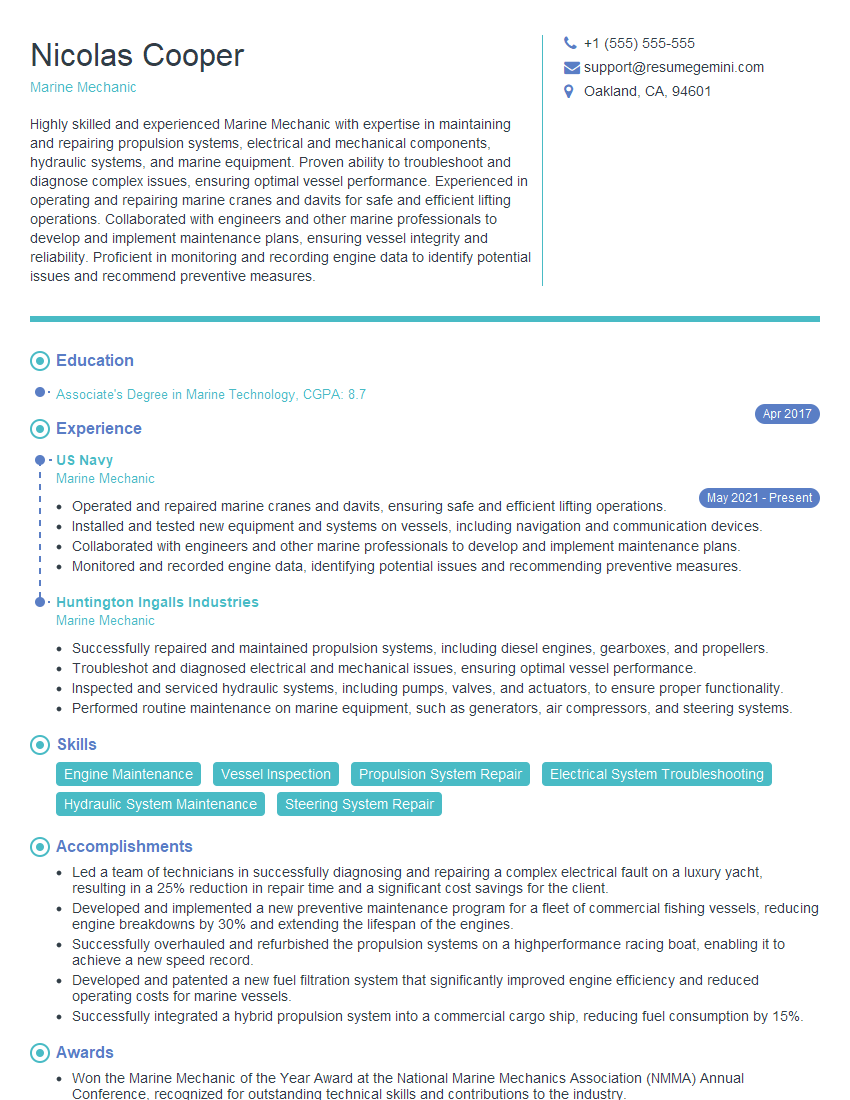The right preparation can turn an interview into an opportunity to showcase your expertise. This guide to Shipboard Maintenance and Repairs interview questions is your ultimate resource, providing key insights and tips to help you ace your responses and stand out as a top candidate.
Questions Asked in Shipboard Maintenance and Repairs Interview
Q 1. Explain your experience with preventative maintenance schedules.
Preventative maintenance schedules are the backbone of reliable shipboard operations. They involve systematically inspecting, servicing, and replacing components before they fail, minimizing downtime and costly emergency repairs. Think of it like regular check-ups for your car – it’s far cheaper to change the oil regularly than to replace the engine.
My experience encompasses developing and implementing these schedules using both manufacturer’s recommendations and our own historical data on equipment lifespan and failure rates. For instance, on one vessel, we analyzed past maintenance logs to identify a recurring issue with a specific type of pump. This led us to adjust the preventative maintenance schedule, increasing the frequency of inspections and preventative replacements for that particular model, ultimately saving the company significant repair costs and potential downtime.
- Developing Schedules: This involves analyzing equipment specifications, identifying critical components, and determining optimal inspection and service intervals.
- Implementing Schedules: This includes training crew members on proper maintenance procedures, documenting completed tasks accurately, and using CMMS (Computerized Maintenance Management System) software to manage and track the schedules effectively.
- Analyzing Data: Regularly reviewing maintenance data to identify trends, potential issues, and opportunities for optimization is crucial. This data-driven approach ensures continuous improvement of the PM schedule.
Q 2. Describe your troubleshooting process for a malfunctioning engine.
Troubleshooting a malfunctioning engine is a systematic process that requires a calm and methodical approach. It’s like solving a complex puzzle, where each clue leads you closer to the solution. My process typically involves:
- Safety First: Securing the area and ensuring all safety protocols are followed is paramount. This includes shutting down non-essential systems and alerting the appropriate personnel.
- Initial Assessment: Gathering information about the nature of the malfunction, such as unusual noises, vibrations, or performance indicators (e.g., reduced power output, increased fuel consumption). This often involves checking gauges and warning lights.
- Visual Inspection: Carefully examining the engine for any visible damage, leaks, or loose connections.
- Systematic Checks: Following a checklist for the specific engine type, checking fuel supply, lubrication system, cooling system, air intake, and exhaust system. I’ll use diagnostic tools like pressure gauges and temperature sensors to pinpoint potential issues.
- Testing & Diagnostics: Employing more advanced diagnostics equipment, if necessary, to identify faults within the engine’s electronic control systems. This might involve using engine diagnostic software or specialized tools.
- Remedial Actions: Once the problem is diagnosed, performing the necessary repairs or replacements. This may involve simple adjustments or more complex interventions, such as replacing a faulty component.
- Testing & Verification: Thoroughly testing the engine to confirm the repair has been successful and the engine is operating safely and efficiently.
Q 3. How do you manage repairs in an emergency situation at sea?
Emergency repairs at sea demand rapid, effective action. The priority is always safety and getting the vessel to a safe location. Imagine a sudden engine failure in a storm – every minute counts. My approach in such situations focuses on:
- Damage Control: First and foremost, assess the extent of the damage and the immediate safety risks. Implementing emergency procedures to mitigate the problem, such as securing loose equipment or diverting power to essential systems.
- Temporary Repairs: Concentrating on temporary repairs to restore essential functionality, enabling safe navigation and reducing the risk of further damage. This might involve using temporary patching materials or bypassing faulty components.
- Communication & Assistance: Immediately contacting shore-based support or other vessels for assistance, providing details about the situation and requesting guidance or emergency repair services.
- Documentation: Meticulously documenting all actions taken, including temporary repairs, and the condition of the vessel. This is crucial for insurance claims and for conducting thorough investigations into the root cause of the emergency.
- Post-Emergency Assessment: Once the immediate danger has passed, conducting a thorough assessment of the damage, planning permanent repairs, and implementing preventative measures to reduce the likelihood of similar occurrences.
Q 4. What are your skills in diagnosing and resolving electrical faults on board?
Diagnosing and resolving electrical faults requires a deep understanding of shipboard electrical systems, which are often complex and critical to safety and operations. My skills involve:
- Understanding Schematics: Interpreting electrical schematics and wiring diagrams to trace circuits and identify potential fault locations. This is the roadmap to finding electrical issues.
- Testing Equipment: Proficiently using multimeters, clamp meters, and other diagnostic equipment to measure voltage, current, and resistance. This helps to pinpoint exactly where the fault is in the circuit.
- Troubleshooting Techniques: Employing systematic troubleshooting techniques to isolate faults, such as checking for loose connections, faulty components, or short circuits. This is a blend of theory and experience.
- Safety Precautions: Strictly adhering to safety regulations when working with high-voltage systems. This is not something to compromise on.
- Repair and Replacement: Performing repairs such as replacing faulty wiring, switches, circuit breakers, or other electrical components. This is where hands-on skill comes in.
- Preventive Maintenance: Conducting preventative maintenance to minimize electrical failures, including inspecting wiring, connectors, and other components. This is a critical aspect of maintaining a safe system.
For example, on one occasion, a sudden power outage affected a crucial navigation system. By systematically checking circuits with my multimeter, I identified a blown fuse in the main distribution panel. A simple replacement quickly restored power, preventing a potentially dangerous situation.
Q 5. Detail your experience with hydraulic system maintenance and repair.
Hydraulic systems are crucial for various shipboard operations, from steering and cargo handling to deck machinery. Maintaining and repairing these systems requires specialized knowledge and skills. My experience includes:
- Understanding Hydraulic Principles: A thorough grasp of hydraulic principles, including pressure, flow, and fluid properties. This forms the foundation of all hydraulic work.
- System Diagnosis: Using pressure gauges, flow meters, and other testing equipment to diagnose problems in hydraulic systems. This is similar to diagnosing electrical systems, but with a different set of tools and principles.
- Leak Detection and Repair: Locating and repairing hydraulic leaks, often involving tracing lines, identifying failing seals, and performing component replacement.
- Component Overhaul: Overhauling hydraulic pumps, cylinders, and valves, which involves disassembling, cleaning, inspecting, and reassembling components. This is where precision and attention to detail are paramount.
- Fluid Management: Properly managing hydraulic fluids, including sampling, testing, and replacing fluids as needed. Incorrect fluids can damage the system.
- Safety Procedures: Following strict safety procedures when working with high-pressure hydraulic systems. This is crucial for personal safety.
I once worked on a repair of a malfunctioning hydraulic steering system. By systematically checking the pressure at each point in the system, I pinpointed a leaking seal in the hydraulic pump. Replacing the seal restored full functionality to the steering system, ensuring the ship’s safe navigation.
Q 6. Describe your familiarity with various types of pumps and their maintenance.
Ships utilize a wide variety of pumps for various purposes, from bilge pumps to fire pumps, and each type requires specific maintenance. My familiarity includes:
- Centrifugal Pumps: These high-volume, low-pressure pumps are commonly used for bilge pumping, ballast transfer, and other general duties. Maintenance includes checking impeller wear, bearings, seals, and motor condition.
- Positive Displacement Pumps: These pumps, such as gear pumps and piston pumps, are used where higher pressure is needed. Maintenance focuses on checking gears, seals, and piston condition and ensuring proper lubrication.
- Diaphragm Pumps: These pumps are often used for handling chemicals or viscous fluids. Maintenance is crucial to ensure the diaphragms are in good condition and that fluid compatibility is maintained.
- Fire Pumps: These pumps are critical for fire-fighting and require rigorous testing and maintenance to ensure they operate reliably under pressure.
Understanding the operating principles of each pump type is essential for effective maintenance. For instance, a failing bearing in a centrifugal pump will manifest as unusual noise and vibration. Regular inspection and lubrication help to avoid such failures.
Q 7. Explain your experience in maintaining refrigeration and air conditioning systems.
Maintaining refrigeration and air conditioning systems on a ship is crucial for the comfort and safety of the crew and for preserving perishable goods. My experience covers:
- Refrigeration Systems: Maintaining and repairing refrigeration systems for cargo holds and food storage involves inspecting compressors, condensers, evaporators, and refrigerant lines, checking refrigerant levels, and identifying leaks.
- Air Conditioning Systems: Maintaining air conditioning systems involves troubleshooting issues with compressors, fans, condensers, and refrigerant circuits. Regular cleaning and filter changes are crucial for optimal performance.
- Refrigerant Handling: Safe and responsible handling of refrigerants, following environmental regulations and safety procedures. This is a critical aspect to avoid environmental damage and personal harm.
- Preventative Maintenance: Regular preventative maintenance tasks, such as cleaning coils, checking refrigerant levels, and lubricating components, help to prevent breakdowns and ensure efficient operation.
One challenge I faced involved a failing refrigeration system in a cargo hold. After a systematic check, I discovered a leak in the refrigerant line. After repairing the leak, properly evacuating the system, and charging it with the correct refrigerant, the system resumed its optimal functionality, preserving the cargo.
Q 8. How do you ensure compliance with safety regulations during maintenance?
Safety is paramount in shipboard maintenance. We adhere to a rigorous safety protocol that begins with a thorough risk assessment before any work commences. This involves identifying potential hazards, such as working at heights, confined spaces, or exposure to hazardous materials. We then implement control measures, including the use of personal protective equipment (PPE), such as harnesses, respirators, and safety glasses, and implement lockout/tagout procedures to prevent accidental energization of equipment. Regular safety briefings and toolbox talks reinforce safe working practices. For example, before commencing work on a generator, we’d ensure it’s properly locked out and tagged out, with multiple crew members verifying the process. Compliance is further ensured through meticulous record-keeping, documenting all safety procedures followed and any incidents or near misses for continuous improvement.
- Pre-job risk assessment and hazard identification.
- Use of appropriate PPE.
- Lockout/Tagout procedures.
- Regular safety briefings and training.
- Detailed record-keeping and incident reporting.
Q 9. What is your experience with welding and fabrication techniques in ship repair?
My experience with welding and fabrication encompasses a wide range of techniques, including MIG, TIG, and stick welding. I’m proficient in repairing and fabricating various ship components, such as hull plates, bulkheads, and piping systems. I’ve worked extensively with stainless steel, mild steel, and aluminum alloys, understanding the specific welding parameters required for each material. On one occasion, I was tasked with repairing a significant crack in a critical bulkhead section using TIG welding. This required precise control and meticulous cleaning to ensure a strong, leak-proof repair that met stringent class society standards. I also possess experience in blueprint reading and utilizing various fabrication tools, including cutting torches, grinders, and plasma cutters. My work consistently adheres to high quality and safety standards.
Q 10. Describe your experience with pipefitting and plumbing systems onboard vessels.
My expertise in pipefitting and plumbing systems extends to both high-pressure and low-pressure systems, involving various materials like copper, steel, and PVC. I’m skilled in pipe cutting, threading, bending, and welding, ensuring leak-free and structurally sound installations. I’ve worked on everything from small-diameter sanitary lines to large-diameter fuel and water lines. Troubleshooting leaks and resolving blockages are integral parts of my responsibilities. For instance, I once successfully diagnosed and repaired a leak in a saltwater cooling system, preventing a significant loss of water and potential damage to the engine. This involved tracing the pipework, identifying the source of the leak using pressure testing, and then executing the repair, followed by rigorous pressure testing to ensure the repair’s effectiveness.
Q 11. How do you manage inventory and spare parts for shipboard maintenance?
Efficient inventory management is crucial for minimizing downtime. We utilize a computerized maintenance management system (CMMS) to track spare parts, recording their location, quantity, and usage history. This allows for accurate forecasting of parts needed for upcoming maintenance tasks and prevents stock-outs. We also implement a robust system of regular stock checks, ensuring that physical inventory matches the CMMS records. An ABC analysis helps prioritize critical spare parts for critical systems, ensuring that we always have enough on hand while controlling inventory costs. We also maintain a close relationship with suppliers to ensure timely delivery of parts in emergencies.
Q 12. Explain your experience with machinery lubrication and its importance.
Machinery lubrication is vital for the longevity and efficiency of shipboard equipment. I’m experienced in selecting the right lubricants based on equipment type, operating conditions, and manufacturer recommendations. This involves understanding different lubricant grades (e.g., ISO VG) and their properties. Regular lubrication involves following a scheduled lubrication plan, ensuring all components receive the correct amount of lubricant at the correct intervals. I’m also proficient in using different lubrication methods, including grease guns, oil cans, and centralized lubrication systems. I understand the importance of proper oil analysis, which can detect early signs of wear and tear, allowing for preventative maintenance before equipment failure. Neglecting lubrication can lead to premature wear, increased friction, and eventual equipment failure, incurring costly repairs and potential safety hazards.
Q 13. How do you handle communication with other crew members during maintenance operations?
Clear and effective communication is paramount during maintenance operations. We use a combination of verbal communication, written work orders, and visual aids (e.g., diagrams, schematics) to ensure everyone understands the task and potential hazards. Before starting any major work, a pre-job briefing ensures all involved understand the scope of work, safety protocols, and potential risks. During the work, regular communication updates keep everyone informed on progress and any issues encountered. Using a dedicated communication channel, such as a radio system or dedicated messaging app, maintains efficiency and minimizes misunderstandings in noisy ship environments. Open communication channels are also critical for reporting any problems or unexpected developments to the Chief Engineer or other relevant personnel.
Q 14. Describe your proficiency in using various diagnostic tools.
My proficiency in using diagnostic tools is extensive, ranging from basic multimeters and pressure gauges to sophisticated diagnostic software for engine systems. I’m skilled in using vibration analyzers to detect early signs of bearing wear and tear, infrared thermometers to identify overheating components, and ultrasonic detectors to locate leaks in hydraulic and pneumatic systems. For engine diagnostics, I’m proficient in using onboard diagnostic systems and specialized software for analyzing engine parameters, troubleshooting faults, and performing predictive maintenance. Proficiency in using these tools allows for rapid problem identification, minimizing downtime and reducing the risk of major failures.
Q 15. Explain your knowledge of different types of shipboard machinery.
Shipboard machinery encompasses a vast array of systems crucial for a vessel’s operation. These can be broadly categorized into main propulsion, auxiliary machinery, and deck machinery. Main propulsion involves the engines (diesel, gas turbine, or nuclear) responsible for propelling the ship. Auxiliary machinery supports the main propulsion and onboard operations, including:
- Electrical systems: Generators, switchboards, distribution panels, providing power throughout the vessel.
- HVAC systems: Heating, ventilation, and air conditioning units maintaining comfortable and safe onboard environments.
- Pumping systems: Ballast water pumps, bilge pumps, fire pumps – essential for ship stability, safety, and cleanliness.
- Refrigeration systems: Maintaining food and cargo at appropriate temperatures.
- Sewage treatment systems: Treating and disposing of wastewater.
Deck machinery facilitates cargo handling and mooring operations and includes winches, cranes, and mooring equipment. Understanding the intricacies of each system is critical for effective maintenance and repair.
For example, I’ve personally worked on the overhaul of a large diesel engine, requiring detailed knowledge of its various components, from fuel injection systems to lubricating oil systems. I’ve also been involved in troubleshooting electrical faults in a generator, necessitating a thorough understanding of electrical circuits and safety protocols.
Career Expert Tips:
- Ace those interviews! Prepare effectively by reviewing the Top 50 Most Common Interview Questions on ResumeGemini.
- Navigate your job search with confidence! Explore a wide range of Career Tips on ResumeGemini. Learn about common challenges and recommendations to overcome them.
- Craft the perfect resume! Master the Art of Resume Writing with ResumeGemini’s guide. Showcase your unique qualifications and achievements effectively.
- Don’t miss out on holiday savings! Build your dream resume with ResumeGemini’s ATS optimized templates.
Q 16. How do you prioritize maintenance tasks based on urgency and importance?
Prioritizing maintenance tasks hinges on a risk-based approach, considering both urgency and importance. Urgency relates to the immediate consequences of failure; importance relates to the long-term impact and operational criticality. I utilize a system combining a criticality matrix with a planned maintenance schedule.
A criticality matrix assigns a score based on factors like safety implications, operational impact, and cost of failure. For instance, a failed steering system rates high on urgency and importance. A less critical system, say, a paint defect on the hull, would score lower. The planned maintenance schedule includes routine inspections and servicing based on manufacturer recommendations and operational hours.
The combination allows me to prioritize tasks effectively. Emergency repairs always take precedence. Then I prioritize those with high criticality scores even if they aren’t immediately urgent. This approach is documented and shared with the team to ensure transparency and accountability.
Q 17. What is your experience with the documentation and reporting of maintenance activities?
Comprehensive documentation and reporting are paramount in shipboard maintenance. I’m proficient in using both computerized maintenance management systems (CMMS) and traditional logbooks. My experience involves meticulously recording all maintenance activities, including:
- Work orders: Detailing the task, parts used, labor hours, and any special instructions.
- Inspection reports: Documenting the findings of routine and special inspections, including any identified defects.
- Repair reports: Describing the repairs performed, including photos or diagrams where applicable.
- Spare parts inventory: Tracking the availability and consumption of spare parts.
This documentation serves multiple purposes: it ensures traceability, facilitates efficient troubleshooting, supports regulatory compliance, and allows for performance analysis to improve maintenance strategies. I’ve personally used various CMMS software, ensuring data integrity and proper reporting to regulatory bodies such as the flag state and classification societies.
Q 18. Describe your approach to training junior personnel in shipboard maintenance.
Training junior personnel is a vital aspect of my role. My approach involves a combination of theoretical instruction, hands-on experience, and mentorship. I begin by providing a solid foundation in the theory of shipboard systems, emphasizing safety regulations and emergency procedures. This includes classroom training with presentations, manuals and videos.
Practical training follows, starting with simple tasks under supervision and gradually increasing complexity. I emphasize the importance of meticulousness, correct use of tools, and adherence to safety protocols. I always encourage them to ask questions and provide regular feedback, both positive and constructive. Mentorship involves guiding them through challenging tasks, sharing my experience, and fostering a culture of continuous learning and improvement. I also facilitate their participation in official training courses when necessary.
For example, I recently mentored a junior engineer through the complete overhaul of a centrifugal pump. By the end of the process, he was confident in performing the task independently and competently. I see successful training as a critical component to team cohesion and safety aboard the vessel.
Q 19. How do you ensure the proper disposal of hazardous waste generated during maintenance?
Proper disposal of hazardous waste is crucial for environmental protection and crew safety. My experience encompasses adhering to international regulations like MARPOL Annex V and utilizing the ship’s approved waste management plan. This involves:
- Segregation: Separating hazardous waste according to type (e.g., oily waste, chemical waste, batteries).
- Storage: Storing hazardous waste in designated, properly labeled containers to prevent spills and leaks.
- Documentation: Maintaining accurate records of the type, quantity, and disposal method of all hazardous waste.
- Disposal: Utilizing approved disposal methods, such as onshore reception facilities or incineration, as per regulations.
I’ve personally overseen the proper disposal of used oil, contaminated rags, and spent batteries, ensuring strict adherence to safety protocols and environmental regulations. Any deviation from standard procedures could lead to significant environmental damage or crew health problems, so I approach this process with the utmost diligence.
Q 20. What is your experience with ballast water management systems?
Ballast water management systems (BWMS) are crucial for preventing the spread of invasive aquatic species. My experience includes the maintenance and operation of various BWMS technologies. This involves regular inspections, testing, and cleaning of the system components, including filters, UV lamps, and treatment units. I am familiar with the different treatment methods used in these systems, including UV irradiation, filtration, and chemical treatment.
Maintaining accurate records of BWMS operation and maintenance is crucial for compliance. This involves keeping detailed logs of treatment performance, cleaning and maintenance activities and any repairs or malfunctions that occur. I understand the importance of regular performance monitoring to ensure the system effectively meets the required discharge standards. I also ensure the system is calibrated according to manufacturer’s recommendations and that the crew are adequately trained to operate and maintain the system efficiently and safely.
Q 21. Explain your experience with the maintenance of deck machinery.
Maintenance of deck machinery requires a thorough understanding of mechanical and hydraulic systems. My experience includes servicing and repairing winches, cranes, and mooring equipment. This involves regular lubrication, inspection of wear and tear, and replacement of worn parts. Hydraulic systems require specialized knowledge of fluid dynamics, pressure, and safety procedures. I’m familiar with troubleshooting hydraulic leaks and repairing or replacing hydraulic components.
Safety is paramount when working with deck machinery. I always ensure proper lockout/tagout procedures are followed before commencing any maintenance or repair work. I’m proficient in using various types of rigging and lifting equipment and adhere strictly to weight limits and safe working load instructions. I’ve personally been involved in the repair of a malfunctioning winch, which required identifying the faulty component, procuring the replacement part, and performing the repair while ensuring the safety of myself and the crew.
Q 22. Describe your familiarity with various types of marine engines.
My experience encompasses a wide range of marine engines, from slow-speed two-stroke diesel engines commonly found in large container vessels to high-speed four-stroke diesel engines used in smaller ships and fast ferries. I’m also familiar with gas turbines, which are increasingly popular for their high power-to-weight ratio, and hybrid propulsion systems incorporating electric motors for greater efficiency and reduced emissions. Understanding their intricacies, from fuel injection systems and lubrication circuits to exhaust gas recirculation (EGR) and turbocharging, is crucial for effective maintenance and troubleshooting.
- Slow-speed two-stroke diesels: These are powerful but require specialized maintenance procedures due to their massive size and complex components. I have experience in overhaul planning, cylinder liner inspections, and piston replacement on these engines.
- High-speed four-stroke diesels: These engines are more common, requiring routine maintenance like oil changes, filter replacements, and valve adjustments. I’m adept at diagnosing faults using diagnostic tools and implementing corrective actions quickly and efficiently.
- Gas turbines: Maintaining gas turbines necessitates a deep understanding of gas dynamics and combustion processes. My experience includes compressor blade inspections, combustor cleaning, and turbine blade monitoring to prevent catastrophic failures.
- Hybrid propulsion systems: These systems integrate diesel engines with electric motors and battery banks. I have practical knowledge of the interaction between different systems and the specific maintenance demands of electric motors, generators, and battery management systems.
Q 23. How do you ensure the proper functioning of the ship’s communication systems?
Ensuring proper functioning of a ship’s communication systems is paramount for safety and efficient operation. This involves regular inspections, preventative maintenance, and prompt troubleshooting. I focus on both internal and external communication systems.
- VHF Radio: Regular testing of the VHF radio is essential for distress calls. This includes checking antenna integrity, transmitter power, and receiver sensitivity. I follow strict procedures for documenting tests and reporting any anomalies.
- GMDSS (Global Maritime Distress and Safety System): The GMDSS equipment, including EPIRB (Emergency Position-Indicating Radio Beacon) and SART (Search and Rescue Transponder), require meticulous maintenance and periodic testing to guarantee reliable operation in emergencies. I’m proficient in conducting these tests and ensuring the equipment meets all IMO standards.
- Inmarsat and other satellite communication systems: These systems provide global communication capabilities. Maintenance includes checking satellite signal strength, antenna alignment, and system software updates to ensure reliable connectivity.
- Internal communication systems: This includes PA systems, internal telephone systems, and network infrastructure. Regular checks, including cable testing and system software updates, are vital to ensure clear and reliable internal communication.
Preventive maintenance schedules, coupled with thorough documentation and adherence to international regulations, are crucial for maintaining the ship’s communication systems in optimal working condition.
Q 24. What is your experience with the maintenance of life-saving appliances?
Maintenance of life-saving appliances is a critical aspect of shipboard operations, directly impacting the safety of crew and passengers. My experience involves regular inspections, servicing, and testing of a wide range of equipment.
- Lifeboats and davits: I’m proficient in conducting thorough inspections of lifeboats, including hull integrity checks, engine operation, and equipment inventories. Davits are regularly tested to ensure their ability to lower lifeboats safely and efficiently. I’m familiar with various types of davits, including gravity davits and electro-hydraulic davits.
- Life rafts: Life rafts require regular inspections and repacking to ensure serviceability. I’m experienced in checking inflation systems, inspecting buoyancy chambers, and verifying the adequacy of survival supplies.
- Life jackets and other personal protective equipment (PPE): I oversee the inspection and inventory management of life jackets, ensuring they are in good condition and readily available for use. This includes regular checks for damage and proper functioning of inflation mechanisms (if applicable).
- Fire-fighting equipment: I’m adept at maintaining and inspecting various types of fire-fighting equipment, including fire extinguishers, fire hoses, and fire detection systems. This involves regular pressure checks, hose testing, and ensuring the availability of adequate supplies.
Adherence to SOLAS (Safety of Life at Sea) regulations is paramount in all aspects of life-saving appliance maintenance, and I meticulously document all inspections and services.
Q 25. Explain your experience in conducting regular inspections and surveys.
Regular inspections and surveys are crucial for identifying potential problems early and ensuring the continued seaworthiness of a vessel. My experience includes conducting both routine inspections and participating in more extensive surveys.
- Daily rounds and inspections: These involve systematic checks of various ship systems, including engine room, deck machinery, and accommodation spaces. This allows for early detection of minor issues before they escalate into major problems.
- Planned Maintenance System (PMS): I’m experienced in developing and managing PMS schedules that encompass preventative maintenance tasks for all shipboard equipment. This ensures that routine maintenance is carried out effectively and efficiently.
- Class surveys: I’ve participated in surveys conducted by classification societies (e.g., ABS, DNV, Lloyd’s Register) to ensure the ship meets required standards. This includes providing documentation and facilitating access for surveyors to various ship systems.
- Internal audits: I conduct internal audits to verify compliance with safety and maintenance procedures. This involves reviewing documentation, conducting visual inspections, and identifying areas for improvement.
Detailed record-keeping is crucial in this process, allowing for efficient tracking of maintenance activities, identification of recurring problems, and planning for future repairs.
Q 26. Describe your knowledge of international maritime regulations related to maintenance.
My knowledge of international maritime regulations related to maintenance is extensive, primarily focusing on SOLAS (Safety of Life at Sea), MARPOL (International Convention for the Prevention of Pollution from Ships), and the ISM Code (International Safety Management Code). I understand the specific requirements for different types of vessels and the consequences of non-compliance.
- SOLAS: This convention sets minimum standards for the safety of ships, including requirements for life-saving appliances, fire protection, and maintenance procedures. I ensure all maintenance activities related to SOLAS requirements are meticulously documented and compliant.
- MARPOL: This convention addresses the prevention of marine pollution. My understanding encompasses the regulations related to oil pollution, garbage disposal, and the maintenance of pollution prevention equipment. I’m familiar with the Oil Record Book and Garbage Record Book maintenance procedures.
- ISM Code: This code requires a Safety Management System (SMS) onboard ships to ensure safe operation. I understand the role of SMS in guiding maintenance procedures, ensuring proper documentation, and facilitating continuous improvement.
Staying current with amendments and updates to these regulations is a continuous process. I regularly consult official publications and participate in training to remain compliant.
Q 27. How do you adapt to changing maintenance requirements and technological advancements?
Adapting to changing maintenance requirements and technological advancements is vital in this field. I achieve this through continuous learning, proactive engagement with new technologies, and a commitment to best practices.
- Continuous Professional Development (CPD): I regularly attend workshops, seminars, and online courses to stay abreast of the latest maintenance techniques, technologies, and regulatory updates.
- New Technologies: I actively seek opportunities to learn and implement new technologies, such as condition-based monitoring systems, predictive maintenance software, and advanced diagnostic tools, to improve efficiency and reduce downtime.
- Industry best practices: I follow industry best practices and benchmarks to ensure that maintenance strategies are optimized for effectiveness and cost-efficiency. This often involves participation in industry forums and networking with peers.
For example, the adoption of digitalization and remote diagnostics is changing how maintenance is performed. I embrace these changes, understanding that adopting advanced technologies improves efficiency and reduces operational costs.
Q 28. Explain your experience with corrosion prevention and control techniques.
Corrosion prevention and control are crucial for maintaining the structural integrity and operational efficiency of a vessel. My experience encompasses various techniques and strategies.
- Protective coatings: I’m familiar with selecting and applying appropriate protective coatings, such as paints, epoxy resins, and zinc coatings, to prevent corrosion on various ship structures and equipment. Proper surface preparation is critical for the longevity of these coatings.
- Cathodic protection: I understand the principles of cathodic protection systems, including sacrificial anodes and impressed current cathodic protection (ICCP), and their application in mitigating corrosion in underwater structures.
- Regular inspections and cleaning: Regular inspections of critical areas prone to corrosion, such as ballast tanks and bilges, are essential for early detection of corrosion and prompt remedial action. Cleaning and removal of corrosive contaminants is also crucial.
- Material selection: Choosing corrosion-resistant materials for new installations and replacements is an important aspect of preventing future corrosion problems. This includes selecting appropriate grades of stainless steel, aluminum alloys, and other corrosion-resistant materials.
Regular monitoring and proactive maintenance are key to minimizing corrosion. A thorough understanding of the corrosive environment and implementing suitable preventative measures are crucial for extending the life of a vessel.
Key Topics to Learn for Shipboard Maintenance and Repairs Interview
- HVAC Systems: Understanding the principles of refrigeration cycles, troubleshooting common HVAC issues, and preventative maintenance procedures. Practical application: Diagnosing and repairing a malfunctioning air conditioning unit.
- Electrical Systems: Knowledge of AC/DC circuits, electrical safety regulations, and troubleshooting electrical faults. Practical application: Repairing a faulty electrical panel or identifying a short circuit.
- Plumbing and Sanitation: Familiarity with plumbing systems, wastewater treatment, and the maintenance of sanitation equipment. Practical application: Locating and repairing a leak in a water pipe.
- Engine Room Operations: Basic understanding of main engines, auxiliary engines, and associated systems. Practical application: Performing routine checks and preventative maintenance on engine room equipment.
- Safety Procedures and Regulations: Deep knowledge of maritime safety regulations, emergency procedures, and risk assessment. Practical application: Responding effectively to an emergency situation onboard the vessel.
- Preventive Maintenance Schedules: Understanding the importance of preventative maintenance, developing and implementing effective schedules, and using CMMS (Computerized Maintenance Management Systems). Practical application: Creating and managing a preventative maintenance schedule for a specific piece of equipment.
- Welding and Fabrication: Basic welding techniques and the ability to perform minor repairs using various welding processes. Practical application: Repairing a damaged metal component using appropriate welding techniques.
- Troubleshooting and Problem-Solving: Demonstrating the ability to systematically identify, analyze, and solve problems encountered during maintenance and repair tasks. Practical application: Using a systematic approach to diagnose and repair a complex mechanical failure.
Next Steps
Mastering Shipboard Maintenance and Repairs opens doors to exciting career opportunities, offering both professional growth and the chance to travel the world. A strong resume is crucial in showcasing your skills and experience to potential employers. Creating an ATS-friendly resume is vital to ensure your application gets noticed. We highly recommend using ResumeGemini to craft a compelling and effective resume that highlights your unique qualifications. ResumeGemini provides examples of resumes tailored to Shipboard Maintenance and Repairs, allowing you to build a truly professional document and stand out from the competition.
Explore more articles
Users Rating of Our Blogs
Share Your Experience
We value your feedback! Please rate our content and share your thoughts (optional).
What Readers Say About Our Blog
Hi, I’m Jay, we have a few potential clients that are interested in your services, thought you might be a good fit. I’d love to talk about the details, when do you have time to talk?
Best,
Jay
Founder | CEO


